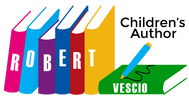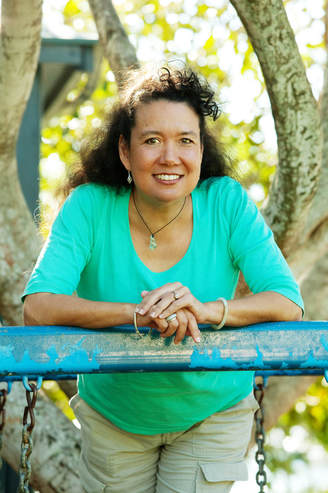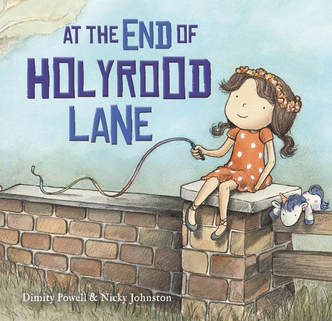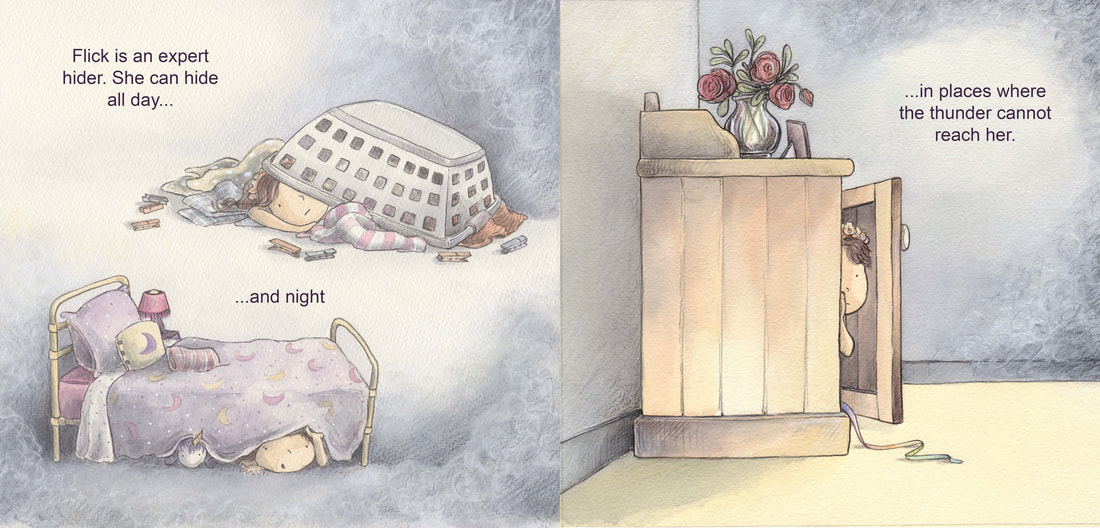|
Today, I’m excited to be interviewing Dimity Powell on my blog to find out all about her latest picture book and more. When Dimity’s not writing, she’s reviewing books or acting as a Books in Homes role model. She is also the Managing Editor for Kids’ Book Review. Dimity’s work spans a wide variety of genres including anthologies, junior novels and digital content. I love how Dimity’s passion for words shines through her work. They always warm my heart. Her words are like a gentle hug, wrapped with love to bring joy. Dimity, this is my way of sharing a BIG warm virtual hug to say THANK YOU. Let’s begin the Q&A … 1. Tell us about At the End of Holyrood Lane. At the End of Holyrood Lane is a metaphorical glimpse at one aspect of domestic violence and how it affects young lives. It is a tale of anxiety shown through the eyes of a small being with an intense dislike for thunderstorms, a fear shared by many young children. It is hoped the deliberate use of objective correlative in this picture book will instil a gentle awareness in young readers suffering their own domestic torment as to how to seek help and shelter from their storms. Few (if any traditionally published) picture books available today address this volatile and woefully prevalent aspect of society without overt explicitness or didactic overtones. At the End of Holyrood Lane does so in a sympathetic, non-threatening way. Although domestic and family violence are the pervading undercurrents, other themes including child parent relationships, hope, resilience and confronting fears are voiced as well, thus giving Flick’s story greater universal appeal. 2. What inspired you to write this book? From the moment, Deirdre Hanna, founder of a leading children’s charity and crisis centre, approached me to write a picture book about domestic violence, I was filled with agitation. This was after all not your everyday topic for an entertaining children’s book. I could not think of one mainstream title or artist currently tackling this topic. Why was that? I wondered. It (DV) was, and still is, however an ongoing horrifying reality of society regardless of culture or creed, a reality that needs more attention if we are ever able to halt it. Why was mainstream children’s literature sidestepping this issue? Deirdre threw me a bone that day, one I could not give up. And so, this story became my challenge, my tormentor and eventually one of my ultimate favourites. I was thrilled EK Books was as foresighted and confident enough to undertake this project with me. 3. We know how important it is for children to have stories read aloud to them. How do you see At the End of Holyrood Lane contributing to this cause? I think the power of this story is its allegorical simplicity. The text is sparse yet packed with emotional punch. The lyrical prose aligns beautifully with Nicky’s illustrations so that small children will be able to identify Flick’s feelings and fears from both the sound of the words used coupled with the emotive colours and movement of the complementing visual narrative. Even if they are not DV sufferers themselves, the all mighty dominance and fear a furious thunderstorm can provoke is something many children (and adults) immediately relate to. Reading this story aloud to youngsters will enable them to ‘read’ or identify emotion in the voice of their shared reading partners be they carers, parents, teachers, or counsellors. Like body language, understanding the nuances of speech is another important factor in literacy development. Picture books exploit this concept phenomenally well. Books like Holyrood Lane not only provide mirrors to a child’s own life but also windows through which they can catch glimpses of the world of others’. By providing platforms for gentle discussion and questioning like this, we encourage understanding and empathy, which is crucial in promoting care and tolerance in any community. Illustration by Nicky Johnston from At the End of Holyrood Lane.
4. How did you feel when you saw Nicky’s illustrations for the book? I wept. With joy. I first saw her roughs at the SCBWI Conference in Sydney in 2016. Once again, Nicky’s intuitive ability to capture my exact intentions was mind-blowing. I immediately fell in love with her rendition of Flick and Flick’s toy unicorn whom we unanimously named, Uni. Nicky understood the metaphor I was adopting and exactly how to portray it; how the storms in Flick’s life were the violator of something more sinister and foreboding. 5. What is the most difficult part of your artistic process? In this case, getting the story and balance of emotion just right. I devoted many hours to word choice and order. Holyrood Lane began as a very different story; one publishers loved but were reluctant to take on owing to the raw gravity of the subject matter. After several rejections, it seemed I’d found the answer why so few picture books on DV existed. But I didn’t stop there. I changed tacks, made the story more appreciable on a global level and, after several rewrites, knew I’d finally done it. Hitting that sweet ‘just right’ spot is the most challenging aspect of the artistic process for me. I’m never happy! 6. How did you break into publishing? When the NSW School Magazine snapped up the very first story I ever submitted, I couldn’t believe it (more weeping). I had prepared myself for years of heartache and rejections. Seeing my story accompanied with pictures was and still is a joy I can barely comprehend. Luckily, years of spiralling into relative obscurity followed that initial success, so my rejection preparations were not for nothing! A competition win led to my first traditional publishing contract for my junior novel, PS Who Stole Santa’s Mail? In fact, entering competitions has been a great proving ground. They prompted me to write something, something good enough to win or at least elicit feedback. They also accustomed me to the de rigueur of submission guidelines. The Fix-It Man evolved from a manuscript I had the guts to submit once. It only attracted a special mention but won the attention of a publisher keen to include it on their lists. There’s a lot to be said for taking a leap of faith. 7. Where is your favourite place to write? Anywhere that is quiet. I need to hear the story. I like to handwrite my first drafts especially if they are picture books. I find a paper notebook and pencil more accommodating than noting ideas on devices because it gives me freedom to Alt Z manually. I drafted my third picture book (due out 2019 / 2020) on an eight-hour flight to Singapore. While the entire planeload of passengers slept, I scribbled away uninterrupted, unbelievably satisfying. Pity I can’t fly somewhere every week. 8. Do you remember the first story you ever read, and the impact it had on you? I read so many books as a kid, the words and titles are a rainbow jumble of wonderful memories, but I do vividly remember Elyne Mitchell’s Silver Brumby series. Her immense affinity with nature and ability to describe it so succinctly on the page really resonated with me. Laura Ingalls Wilder's Little House on the Prairie series had a similar affect. Both these writers were able to create incredibly genuine characters with whom I could really empathise and identify. I was convinced we should have had a horse and covered wagon instead of a Ford Falcon when I was thirteen! (I still think so; I mean, Fords, really?) 9. What were some of your favourite children’s books as a child? All the usual suspects: anything by Enid Blyton, Trixie Beldon, Silver Brumby but also anything that had a horse, a dog or a bird in it: James Harriet series, Cricket in Times Square, The Wolfling, Snowgoose, The Giant Jam Sandwich, Stormboy, The Cotswold Adventures, Fly-By-Night (K M Peyton), Bertha the Racing Pigeon. I think I should have been a Vet. 10. What’s on the horizon for you next? Sunshine and Lollipops? Actually, my story by the same name appears in a novel anthology already so perhaps I should just focus on Holyrood Lane for now. The official launch is 23 September in Brisbane so I need to get my marketing-party-head on. There is a new picture book due out next year that I’m quietly delighted about, and a couple more picture books of mine will feature on the Kindergo App later this year. More short stories are always popping up in an anthology somewhere too so keep your eyes on that horizon! While I’m still reviewing, presenting writing camps and coordinating blogging events for the next SCBWI Conferenced in Sydney next year, writing time is at a premium. My one writing objective is to write more! Thanks for being awesome, Dimity. Tickled pink to be here, Robert! You can find out more about Dimity and her books here: www.dimitypowell.com Title: At the End of Holyrood Lane ISBN: 9781925335767 Release Date: September 2018 Price: $24.99 Hardback Written by: Dimity Powell Illustrated by: Nicky Johnston https://ekbooks.org/product/at-the-end-of-holyrood-lane/
6 Comments
|
Welcome to my blog page!
Here you will find the latest news and updates on my writing and published books. Archives
November 2023
Categories |
- Home
- About
-
Books
- No Matter Who We’re With
- Marlo Can Fly
- Barnaby and the Lost Treasure of Bunnyville
- Jack and Mia
- Ella Saw The Tree
- Eric Finds A Way
- Finn and Puss
- Bigger Than Yesterday, Smaller Than Tomorrow
- The Box Cars
- Window Of Hope
- Under The Same Sky
- The Voyage
- Happiness Is A Cloud
- Into the Wild
- The Art of Words
- Seal Child
- Wombat and Joey Roo
- A Squiggly Line
- Finding You
- The Storytellers
- Red
- Patience
- Nature’s Song
- Today
- Media
- Resources
- Testimonials
- Blog
- Contact
Copyright © 2022 Robert Vescio - Webdesign by Inge Walter | Storm Designs




 RSS Feed
RSS Feed